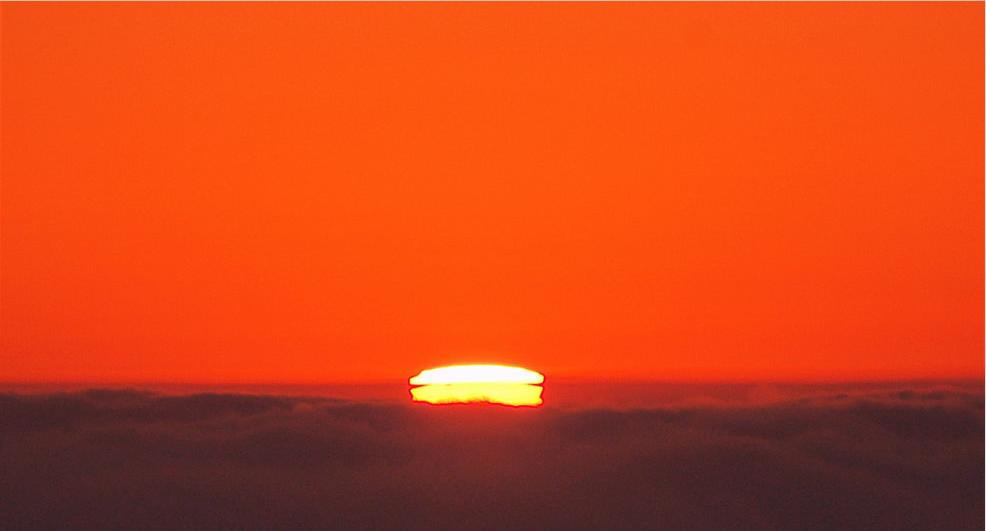Balloon Ducted Mock-Mirage Sunset
Exploring the Phenomenon of Balloon Ducted Mock-Mirage Sunsets
Have you ever gazed up at the sky during a beautiful sunset and wondered about the fascinating optical illusions that can occur? One such mesmerizing phenomenon is the balloon ducted mock-mirage sunset. In this article, we will delve into the intricacies of this atmospheric optics marvel and unravel the science behind its formation.
What is a Balloon Ducted Mock-Mirage Sunset?
A balloon ducted mock-mirage sunset occurs when a hot air balloon floats above a strong inversion layer in the atmosphere. An inversion layer refers to a region where temperature increases with height instead of the usual decrease. This inversion layer creates a duct, or a channel, in which light rays can travel, leading to the formation of a mock-mirage.
Unveiling the Mysteries of the Ducted Mock-Mirage
Within this ducted mock-mirage, one can observe a lower mirage slice that contains not one, but two images of the sun. These images appear as an upright and an inverted sun. The presence of both images is a result of the bending of light rays as they pass through the different layers of air with varying temperatures and densities.
The Role of Temperature Inversions
Temperature inversions play a crucial role in the formation of balloon ducted mock-mirage sunsets. Normally, as you ascend higher into the atmosphere, the temperature decreases. However, in an inversion layer, this pattern is reversed, with the temperature increasing instead. This inversion creates a stable layer of air that acts as a barrier for light rays, causing them to bend and follow a curved path within the duct.
Understanding Mirage Formation
Mirages, in general, are optical illusions that occur due to the bending of light rays as they pass through air layers with varying temperatures. The balloon ducted mock-mirage sunset is a specific type of mirage that occurs when the bending of light within the duct creates an image of the sun that appears both upright and inverted.
The Beauty of Optical Illusions
One of the remarkable aspects of balloon ducted mock-mirage sunsets is their visual allure. The presence of two sun images, one upright and one inverted, creates a surreal and dreamlike atmosphere. It is truly a spectacle to behold, with the sun seemingly defying the laws of physics and appearing in multiple positions simultaneously.
A Photographer's Delight
For photographers and sky enthusiasts, capturing a balloon ducted mock-mirage sunset is a rare and captivating opportunity. The unique combination of colors, shapes, and mirage effects creates a visually stunning image that can leave viewers in awe. It is a testament to the wonders of nature and the endless possibilities for artistic expression.
The Importance of Atmospheric Conditions
To witness a balloon ducted mock-mirage sunset, specific atmospheric conditions must align. The presence of a strong inversion layer, coupled with a hot air balloon floating above it, sets the stage for this optical phenomenon. These conditions are not common and require a fortuitous combination of factors to occur simultaneously.
Exploring Further
The balloon ducted mock-mirage sunset is just one example of the captivating atmospheric optics phenomena that grace our skies. From rainbows and halos to mirages and glories, there is an entire realm of visual wonders waiting to be discovered. By delving deeper into the science behind these phenomena, we can gain a greater appreciation for the intricate workings of our atmosphere and the beauty it bestows upon us.
A Reminder of Nature's Splendor
The balloon ducted mock-mirage sunset serves as a reminder of the vastness and complexity of our natural world. It is a testament to the interplay between light, temperature, and atmospheric conditions. By taking the time to observe and understand these optical marvels, we can cultivate a deeper connection with the environment around us and marvel at the wonders that unfold above our heads. So next time you witness a breathtaking sunset, take a moment to appreciate the hidden magic that may be lurking within.

Airborne Ducted Sunset. Michael J. Slezak (images) took this sunset from a hot air balloon ( glory). A strong inversion layer below the balloon has produced a ducted mock-mirage. The lower mirage slice contains two images, an upright and an inverted sun.
Image ©Kevin Baird, shown with permission.
Note: this article has been automatically converted from the old site and may not appear as intended. You can find the original article here.
Reference Atmospheric Optics
If you use any of the definitions, information, or data presented on Atmospheric Optics, please copy the link or reference below to properly credit us as the reference source. Thank you!
-
<a href="https://atoptics.co.uk/blog/balloon-ducted-mock-mirage-sunset-2/">Balloon Ducted Mock-Mirage Sunset</a>
-
"Balloon Ducted Mock-Mirage Sunset". Atmospheric Optics. Accessed on November 26, 2024. https://atoptics.co.uk/blog/balloon-ducted-mock-mirage-sunset-2/.
-
"Balloon Ducted Mock-Mirage Sunset". Atmospheric Optics, https://atoptics.co.uk/blog/balloon-ducted-mock-mirage-sunset-2/. Accessed 26 November, 2024
-
Balloon Ducted Mock-Mirage Sunset. Atmospheric Optics. Retrieved from https://atoptics.co.uk/blog/balloon-ducted-mock-mirage-sunset-2/.